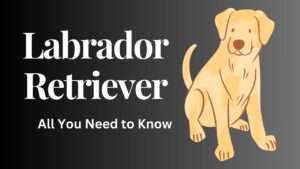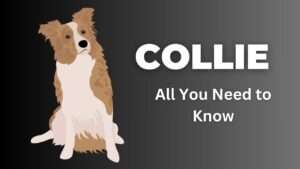Nestled within the fascinating world of canine companionship lies a breed that exudes intelligence, agility, and boundless energy—the Border Collie.
With its striking appearance and remarkable abilities, this breed has captured the hearts of dog lovers worldwide.
But what makes Border Collies so special? What sets them apart from other breeds? Join us as we embark on a journey to uncover all there is to know about these remarkable dogs.
Contents Overview
Breed Overview
Let’s delve deeper into the world of Border Collies, exploring their size, appearance, and lifespan.
- Size:
- Border Collies are a medium-sized breed, exhibiting a well-proportioned physique that exudes athleticism and agility.
- On average, male Border Collies stand between 19 to 22 inches (48 to 56 cm) tall at the shoulder, while females typically measure slightly smaller, ranging from 18 to 21 inches (46 to 53 cm).
- Despite their moderate size, Border Collies possess remarkable strength and endurance, enabling them to excel in various physical activities and tasks.
- Appearance:
- The Border Collie’s appearance is characterized by a distinctive double coat that offers protection from the elements.
- Their outer coat is typically dense, weather-resistant, and can come in a variety of colors, including black and white, red and white, blue merle, and tricolor.
- With an alert expression and keen gaze, Border Collies possess an unmistakable presence that reflects their innate intelligence and attentiveness.
- Life Span:
- Border Collies are known for their longevity, with a typical lifespan ranging from 12 to 15 years.
- Proper care, nutrition, and regular exercise play pivotal roles in ensuring the health and well-being of Border Collies, potentially extending their lifespan.
- While genetics and individual health factors may influence lifespan, providing a loving and nurturing environment can contribute to a fulfilling and happy life for these remarkable dogs.
History and Origins of Border Collies
Let’s delve into the captivating tale of how these extraordinary dogs came to be.
- Origins in Border Regions:
- The origins of the Border Collie can be traced back to the rugged border regions between England and Scotland, where they were meticulously bred for their exceptional herding abilities.
- Developed to work alongside shepherds in these challenging terrains, Border Collies played a vital role in managing livestock, particularly sheep, with precision and efficiency.
- Development as a Herding Breed:
- Border Collies evolved from ancient droving breeds that inhabited the British Isles, with influences from Roman and Viking dogs.
- Through selective breeding and careful selection for working traits, the breed gradually emerged as the quintessential herding dog, revered for its keen intellect and unmatched work ethic.
- Contributions of Pioneering Breeders:
- Pioneering breeders such as Adam Telfer and James Reid emerged as key figures in shaping the modern Border Collie breed.
- Their dedication to preserving and refining the breed’s working abilities laid the foundation for the Border Collie’s enduring legacy as a premier herding dog.
- Recognition and Standardization:
- The Border Collie’s exceptional talents caught the attention of dog enthusiasts beyond the borders of the British Isles, leading to its recognition by kennel clubs worldwide.
- The breed was officially recognized by the International Sheep Dog Society (ISDS) in the early 20th century, with breed standards established to maintain the breed’s working integrity.
- Evolution into Versatile Companions:
- While rooted in their heritage as working dogs, Border Collies have also thrived in various roles beyond the farm.
- Their intelligence, trainability, and versatility have made them well-suited for activities such as agility, obedience, flyball, and even search and rescue work.
- Modern-Day Popularity:
- In recent years, Border Collies have captured the hearts of dog lovers worldwide, gaining popularity as beloved family pets, performance champions, and esteemed working partners.
- Their enduring appeal lies in their exceptional intelligence, boundless energy, and unwavering devotion to their human companions.
Temperament and Personality of Border Collie
Let’s delve into the captivating world of Border Collie temperament and personality.
- Intelligence and Problem-Solving Skills:
- Border Collies are widely regarded as one of the most intelligent dog breeds, capable of learning complex tasks and commands with remarkable ease.
- Their sharp minds and quick wit enable them to excel in various canine sports, obedience trials, and problem-solving activities.
- This high level of intelligence requires mental stimulation and challenges to keep them engaged and fulfilled.
- Work Ethic and Drive:
- Bred for generations to work alongside shepherds, Border Collies possess an innate drive and work ethic that is unrivaled.
- They thrive on having a job to do and excel in tasks that require focus, precision, and determination.
- Whether herding livestock on the farm or participating in agility competitions, Border Collies approach every task with enthusiasm and dedication.
- Energy and Enthusiasm:
- Border Collies are renowned for their boundless energy and enthusiasm, which can be both exhilarating and demanding for their owners.
- They require ample exercise and mental stimulation to channel their energy constructively and prevent boredom and potential behavioral issues.
- Engaging in activities such as long walks, hikes, and interactive play sessions is essential to keep them physically and mentally satisfied.
- Sensitivity and Bonding:
- Despite their strong work ethic and drive, Border Collies are also known for their sensitivity and deep bond with their human companions.
- They are highly attuned to their owner’s emotions and thrive on positive reinforcement and affectionate interactions.
- Building a strong bond based on mutual trust and respect is essential for fostering a harmonious relationship with a Border Collie.
- Trainability and Obedience:
- Border Collies excel in obedience training due to their eagerness to please and quick learning abilities.
- They thrive in environments where training is structured, consistent, and rewards-based, allowing them to showcase their full potential.
- Proper training and socialization from an early age are crucial for shaping a well-behaved and well-adjusted Border Collie.
Exercise and Training Needs of Border Collie
Let’s explore the essential exercise and training needs of Border Collies to ensure they lead happy, healthy, and fulfilling lives.
- Exercise Requirements:
- Border Collies are a high-energy breed that thrives on regular exercise to maintain their physical health and mental well-being.
- They require a minimum of 1-2 hours of vigorous exercise each day to prevent boredom and positively channel their energy.
- Engaging in activities such as long walks, hikes, jogging, or interactive play sessions in a securely fenced area allows Border Collies to burn off excess energy and stay mentally stimulated.
- Mental Stimulation:
- In addition to physical exercise, Border Collies require ample mental stimulation to keep their agile minds engaged.
- Puzzle toys, interactive games, and training sessions that challenge their problem-solving skills are excellent ways to provide mental enrichment.
- Engaging in activities such as agility training, obedience trials, or even learning new tricks can help satisfy their need for mental stimulation and keep them mentally sharp.
- Training and Obedience:
- Border Collies are highly intelligent and eager to please, making them highly trainable dogs.
- Consistent, positive reinforcement-based training methods are essential for shaping desired behaviors and preventing potential behavioral issues.
- Training should be structured, varied, and tailored to their individual needs, focusing on building a strong bond and mutual trust between the owner and the dog.
- Socialization:
- Early and ongoing socialization is crucial for Border Collies to develop into well-adjusted and confident companions.
- Exposing them to a variety of people, animals, environments, and experiences from a young age helps prevent fearfulness and aggression.
- Dog parks, obedience classes, and supervised playdates with other dogs are excellent opportunities for socialization and building positive interactions.
- Supervised Playtime:
- While Border Collies thrive on play and interaction, it’s important to supervise their playtime, especially with smaller animals or children.
- Their herding instincts may lead them to try to control or chase smaller animals, so early training and supervision are essential to prevent unwanted behaviors.
- Providing structured play activities and toys that encourage appropriate play behavior can help prevent boredom and destructive behaviors.
Border Collie's coat: Type and Length
Let’s delve into the intricacies of the Border Collie’s coat:
- Coat Type:
- Border Collies possess a double coat, consisting of a dense, weather-resistant outer coat and a soft, insulating undercoat.
- The outer coat is typically medium-length and can vary in texture, ranging from smooth to slightly wavy or even rough.
- This double-layered coat protects from harsh weather conditions, making Border Collies well-suited for working in diverse environments.
- Coat Length:
- The length of a Border Collie’s coat can vary depending on genetics, lineage, and individual differences.
- Generally, Border Collies have a moderate coat length, falling somewhere between short and long.
- The length of the coat may be slightly longer around the neck, chest, and tail, creating a ruff-like appearance in some individuals.
- Grooming Requirements:
- Despite their moderate coat length, Border Collies require regular grooming to keep their coats healthy and free of mats and tangles.
- Weekly brushing with a slicker brush or grooming rake helps remove loose hair, dirt, and debris, preventing mats from forming.
- During seasonal shedding periods, more frequent brushing may be necessary to manage excessive shedding and keep the coat in good condition.
- Coat Colors and Patterns:
- Border Collies come in a variety of coat colors and patterns, including black and white, red and white, blue merle, and tri-color.
- The most common color pattern is black and white, followed by red and white, with variations in markings and distribution across the body.
- Blue Merle Border Collies exhibit a marbled or speckled pattern of blue, gray, black, and white, creating a striking and unique appearance.
Grooming and Care
Let’s delve into the key components of grooming and care for Border Collies:
- Brushing:
- Border Collies have a double coat that requires regular brushing to remove loose hair, dirt, and debris.
- Use a slicker brush or grooming rake to brush your Border Collie’s coat at least once a week, focusing on areas prone to matting and tangling.
- During shedding seasons, such as spring and fall, more frequent brushing may be necessary to manage excessive shedding and prevent mats from forming.
- Bathing:
- Border Collies generally do not require frequent baths unless they get exceptionally dirty or develop a strong odor.
- Use a mild dog shampoo and lukewarm water to bathe your Border Collie, ensuring thorough rinsing to remove all soap residue.
- Avoid over-bathing, as it can strip the coat of its natural oils and lead to dryness and skin irritation.
- Nail Care:
- Regular nail trimming is essential to prevent overgrowth, discomfort, and potential injury for your Border Collie.
- Use a quality pair of dog nail clippers to trim your Border Collie’s nails every 4-6 weeks, or as needed based on the rate of growth.
- Be cautious not to cut into the quick, which contains blood vessels and nerves, causing pain and bleeding.
- Ear Cleaning:
- Border Collies are prone to ear infections due to their floppy ears and trapped moisture.
- Check your Border Collie’s ears regularly for signs of redness, swelling, or discharge, indicating a possible infection.
- Use a veterinarian-approved ear cleaning solution and cotton balls to gently clean the ears, avoiding insertion into the ear canal to prevent injury.
- Dental Hygiene:
- Dental care is crucial for maintaining your Border Collie’s oral health and preventing dental issues such as tartar buildup and gum disease.
- Brush your Border Collie’s teeth regularly using a dog-specific toothbrush and toothpaste, or provide dental chews and toys to help reduce plaque and tartar accumulation.
- Schedule regular dental check-ups with your veterinarian to monitor your Border Collie’s dental health and address any potential issues promptly.
- Coat Maintenance:
- In addition to brushing, regular coat maintenance is essential for keeping your Border Collie’s coat healthy and free of mats and tangles.
- Trim any excess hair around the ears, paws, and sanitary areas to prevent matting and maintain cleanliness.
- Consider professional grooming services, such as a trim or tidy-up, every few months to keep your Border Collie looking neat and well-groomed.
Shedding Level
Let’s explore how to navigate shedding season with your Border Collie:
- Shedding Patterns:
- Border Collies experience moderate shedding year-round, with heavier shedding typically occurring during seasonal transitions, such as spring and fall.
- Shedding is a natural process for dogs to remove dead hair and maintain a healthy coat, but the frequency and intensity may vary depending on factors such as genetics, diet, and overall health.
- Regular Brushing:
- Brushing your Border Collie regularly is key to managing shedding and keeping loose hair under control.
- Use a slicker brush or grooming rake to remove dead hair and prevent mats and tangles from forming in the coat.
- Aim to brush your Border Collie at least once a week, increasing frequency during shedding seasons to manage excessive hair loss.
- Bathing and Coat Maintenance:
- While bathing your Border Collie too frequently can strip the coat of its natural oils and lead to dryness, occasional baths with a mild dog shampoo can help remove loose hair and reduce shedding.
- Pay attention to coat maintenance by trimming any excess hair around the ears, paws, and sanitary areas to prevent matting and tangling, which can exacerbate shedding.
- Healthy Diet:
- Providing your Border Collie with a balanced diet rich in essential nutrients, vitamins, and omega-3 fatty acids can promote healthy skin and coat, reducing excessive shedding.
- Consult with your veterinarian to determine the best diet for your Border Collie based on their age, weight, activity level, and specific nutritional needs.
- Environmental Factors:
- Environmental factors such as temperature, humidity, and indoor heating can influence shedding levels in Border Collies.
- Maintaining a comfortable indoor environment and providing adequate hydration can help minimize stress-induced shedding and promote overall coat health.
- Regular Veterinary Check-ups:
- Schedule regular veterinary check-ups for your Border Collie to monitor their overall health and address any underlying issues that may contribute to excessive shedding, such as allergies or skin conditions.
- Your veterinarian can guide managing shedding and recommend appropriate treatments or supplements to support your Border Collie’s coat health.
Common Health Issues
Let’s explore some of the prevalent health concerns in Border Collies:
- Hip Dysplasia:
- Hip dysplasia is a genetic condition characterized by abnormal development of the hip joints, leading to arthritis and mobility issues.
- Border Collies may be prone to hip dysplasia, especially if there is a history of the condition in their lineage.
- Symptoms include limping, difficulty rising or jumping, and decreased activity level.
- Collie Eye Anomaly (CEA):
- Collie Eye Anomaly is an inherited eye condition that affects the retina and can lead to vision impairment or blindness.
- Border Collies may carry the gene for CEA, which can be detected through genetic testing.
- Regular eye examinations by a veterinary ophthalmologist can help monitor the progression of the condition and determine appropriate management strategies.
- Epilepsy:
- Epilepsy is a neurological disorder characterized by recurrent seizures, which may range from mild to severe in intensity.
- Border Collies may be predisposed to epilepsy, although the exact cause is often unknown.
- Management of epilepsy in Border Collies typically involves medication to control seizures and regular monitoring by a veterinarian.
- Progressive Retinal Atrophy (PRA):
- Progressive Retinal Atrophy is a degenerative eye disease that leads to progressive vision loss and eventual blindness.
- Border Collies may carry the gene for PRA, which can be identified through genetic testing.
- Early detection and regular monitoring by a veterinary ophthalmologist can help manage the condition and maintain the quality of life for affected dogs.
- Sensitivity to Ivermectin:
- Border Collies may have a genetic sensitivity to certain medications, such as ivermectin, commonly used to treat parasites.
- Administering ivermectin to sensitive Border Collies can lead to severe neurological symptoms and even death.
- It’s crucial to inform your veterinarian about your Border Collie’s breed and potential sensitivity to certain medications to avoid adverse reactions.
- Allergies:
- Border Collies may be prone to allergies, including food allergies, environmental allergies, and flea allergies.
- Symptoms of allergies in Border Collies may include itching, skin irritation, ear infections, and gastrointestinal upset.
- Identifying and avoiding potential allergens, along with appropriate veterinary care and management, can help alleviate symptoms and improve your Border Collie’s quality of life.
Drooling Level
Border Collies are not typically known for excessive drooling. Compared to some other breeds, such as Mastiffs or Saint Bernards, Border Collies tend to be relatively dry-mouthed. While individual dogs may vary in their drooling tendencies, it’s uncommon for Border Collies to drool excessively under normal circumstances.
However, occasional drooling may occur in Border Collies in certain situations, such as:
- Hunger or anticipation: Some Border Collies may drool a bit when they’re hungry or excited about mealtime or treats.
- Heat or exertion: Like all dogs, Border Collies may pant to regulate their body temperature when they’re hot or after vigorous exercise. While panting helps cool them down, it can also result in some drool.
- Stress or anxiety: In stressful situations, some dogs may drool as a response to anxiety or nervousness. This could occur during visits to the veterinarian, car rides, or other unfamiliar or uncomfortable situations.
- Medical issues: In rare cases, excessive drooling in Border Collies could indicate an underlying medical problem, such as dental issues, mouth sores, or nausea. If your Border Collie starts drooling excessively without an obvious cause, it’s important to consult with a veterinarian to rule out any health concerns.
Overall, while Border Collies may drool occasionally, it’s not a characteristic trait of the breed. If you notice persistent or excessive drooling in your Border Collie, especially if it’s accompanied by other symptoms or changes in behavior, it’s best to seek guidance from a veterinarian to ensure your dog’s health and well-being.
Nutrition and Diet
Let’s explore the key considerations for optimizing nutrition and diet for your Border Collie:
- High-Quality Dog Food:
- Choose a high-quality commercial dog food that is specifically formulated for active breeds like Border Collies.
- Look for dog foods that list meat as the primary ingredient, such as chicken, beef, or fish, to ensure adequate protein content.
- Avoid dog foods that contain fillers, artificial additives, and preservatives, as these may be detrimental to your Border Collie’s health.
- Balanced Nutrients:
- Ensure that your Border Collie’s diet provides a balance of essential nutrients, including protein, carbohydrates, fats, vitamins, and minerals.
- Protein is particularly important for Border Collies to support their muscle development and maintenance, so choose dog foods with a high protein content.
- Carbohydrates from sources like whole grains, fruits, and vegetables provide energy and fiber for digestive health.
- Portion Control:
- Monitor your Border Collie’s portion sizes to prevent overeating and maintain a healthy weight.
- Follow the feeding guidelines provided on the dog food packaging, adjusting portion sizes based on your dog’s age, weight, activity level, and metabolic rate.
- Avoid free-feeding or leaving food out all day, as this can lead to obesity and associated health issues.
- Adequate Hydration:
- Ensure that your Border Collie has access to fresh, clean water at all times to prevent dehydration and support proper bodily functions.
- Monitor your dog’s water intake, especially during hot weather or after vigorous exercise, and encourage them to drink regularly.
- Regular Feeding Schedule:
- Establish a consistent feeding schedule for your Border Collie, offering meals at the same times each day.
- Consistency in feeding times helps regulate your dog’s metabolism and digestion, reducing the risk of digestive upset.
- Special Dietary Considerations:
- Some Border Collies may have specific dietary needs or sensitivities, such as allergies or digestive issues.
- Consult with your veterinarian to determine if your Border Collie requires a specialized diet or if any dietary modifications are necessary to address specific health concerns.
Living Environment and Housing
Let’s explore how to create the ideal housing and living environment for your Border Collie:
- Space and Exercise Needs:
- Border Collies are highly active dogs that require plenty of space to run, play, and explore.
- Ideally, provide your Border Collie with access to a securely fenced yard where they can engage in off-leash exercise and playtime.
- If you live in an apartment or urban environment, commit to regular walks, visits to the dog park, or participation in canine sports to meet your Border Collie’s exercise needs.
- Mental Stimulation:
- Border Collies are incredibly intelligent and thrive on mental stimulation and challenges.
- Incorporate interactive toys, puzzle feeders, and training sessions into your Border Collie’s daily routine to keep their minds engaged and prevent boredom.
- Engage in activities such as obedience training, agility courses, or interactive games like fetch or hide-and-seek to stimulate your Border Collie’s cognitive abilities.
- Socialization and Companionship:
- Border Collies are social animals that enjoy the company of their human family members and other dogs.
- Provide opportunities for your Border Collie to socialize with other dogs and people from a young age to develop good manners and positive social behaviors.
- Avoid leaving your Border Collie alone for extended periods, as they may become bored or anxious without companionship.
- Safe and Secure Environment:
- Ensure that your living environment is safe and secure for your Border Collie, free from hazards such as toxic plants, chemicals, or small objects that could be swallowed.
- Securely fence outdoor areas to prevent your Border Collie from wandering off or getting into trouble.
- Supervise your Border Collie when outdoors, especially near bodies of water or busy roads, to prevent accidents or injuries.
- Climate Considerations:
- Border Collies can adapt to a variety of climates, but it’s essential to provide adequate shelter and protection from extreme weather conditions.
- During hot weather, provide access to shade, freshwater, and indoor air conditioning to prevent heat-related illnesses.
- In cold weather, provide a warm, dry shelter and appropriate clothing or bedding to keep your Border Collie comfortable.
- Mental and Emotional Well-Being:
- Pay attention to your Border Collie’s mental and emotional well-being, offering plenty of love, attention, and positive reinforcement.
- Establish a consistent routine and provide structure and predictability to help your Border Collie feel secure and confident in their environment.
- Monitor your Border Collie for signs of stress, anxiety, or boredom, and address any concerns promptly with appropriate enrichment activities and training.
Barking Level
Generally, Border Collies are not considered to be excessive barkers, but they may vocalize to communicate or express themselves in certain situations. Here are some considerations regarding the barking level of Border Collies:
- Communication:
- Border Collies may bark to communicate their needs, alert their owners to potential threats or changes in their environment, or express excitement or frustration.
- Barking can be a form of communication for Border Collies, especially if they are trying to convey something important or seek attention from their owners.
- Herding Instincts:
- Border Collies have strong herding instincts, which may manifest in behaviors such as barking, nipping, or circling.
- While barking is not the primary herding behavior of Border Collies, they may bark occasionally to control or move livestock, especially if they are trained to do so.
- Environmental Factors:
- Border Collies may bark in response to environmental stimuli such as unfamiliar noises, strangers approaching their territory, or other animals passing by.
- Providing adequate socialization and exposure to different environments from a young age can help reduce anxiety-related barking in Border Collies.
- Training and Socialization:
- Proper training and socialization play a crucial role in managing barking behavior in Border Collies.
- Positive reinforcement-based training methods can help teach Border Collies appropriate barking behavior and provide alternative ways to communicate or respond to stimuli.
- Teaching commands such as “quiet” or “enough” can help discourage excessive barking and promote calm behavior.
- Exercise and Mental Stimulation:
- Ensuring that Border Collies receive sufficient physical exercise and mental stimulation can help prevent boredom-related barking.
- Engage your Border Collie in regular activities such as walks, runs, play sessions, and training exercises to keep them mentally and physically stimulated.
- Attention and Interaction:
- Border Collies are highly intelligent and thrive on human interaction and attention.
- Barking may be a way for Border Collies to seek attention or engage their owners in play or activities.
- Providing regular companionship, training, and enrichment activities can help satisfy your Border Collie’s need for interaction and reduce attention-seeking barking.
Trainability Level
Let’s explore why Border Collies are considered paragons of trainability:
- Remarkable Intelligence:
- Border Collies are often hailed as one of the smartest dog breeds, possessing an extraordinary capacity for learning and problem-solving.
- Their quick wit, sharp observational skills, and ability to make connections enable them to grasp new concepts and commands with remarkable speed and accuracy.
- Eagerness to Please:
- Border Collies are highly motivated by praise, rewards, and positive reinforcement, making them eager to please their owners and trainers.
- They thrive on learning new tasks and excelling in training sessions, fueled by a strong desire to earn praise and approval from their human companions.
- Work Ethic and Drive:
- Bred for generations to work alongside shepherds, Border Collies possess an unparalleled work ethic and drive that makes them highly trainable in various disciplines.
- They are inherently motivated to perform tasks and excel in activities that engage their instincts and talents, such as herding, agility, and obedience trials.
- Focus and Concentration:
- Border Collies are known for their intense focus and concentration, allowing them to maintain attention on tasks for extended periods without distraction.
- Their ability to tune out distractions and remain attentive to their handler’s cues makes them ideal candidates for precision training and competitive sports.
- Versatility in Training:
- Border Collies excel in a wide range of training activities and disciplines, from basic obedience and agility to advanced tricks and herding trials.
- Their versatility and adaptability make them well-suited for various roles, including working dogs, service dogs, therapy dogs, and beloved family companions.
- Bonding with Their Handler:
- Border Collies form strong bonds with their handlers based on trust, respect, and mutual understanding.
- Building a positive and trusting relationship with your Border Collie through consistent training, clear communication, and affectionate interactions is key to unlocking their full potential.
Socialization and Interaction
Let’s explore the importance of socialization and interaction for Border Collies and how to foster healthy relationships:
- Early Socialization:
- Introduce your Border Collie to a variety of people, animals, environments, and experiences during their critical socialization period (usually between 3 to 16 weeks of age).
- Exposing them to different sights, sounds, and smells helps build their confidence, reduce fearfulness, and prevent behavioral issues later in life.
- Positive Experiences:
- Create positive associations with new people, places, and situations by offering treats, praise, and gentle encouragement during socialization outings.
- Allow your Border Collie to explore at their own pace, gradually increasing exposure to new experiences as they become more comfortable and confident.
- Interaction with Humans:
- Border Collies form strong bonds with their human family members and thrive on companionship and interaction.
- Spend quality time engaging in activities such as training sessions, playtime, walks, and cuddle sessions to strengthen your bond and build trust.
- Playdates and Dog Parks:
- Arrange playdates with other dogs and visits to dog-friendly parks to provide opportunities for your Border Collie to socialize and interact with their canine counterparts.
- Supervise interactions to ensure safety and monitor for appropriate play behavior, intervening if necessary to prevent conflicts or rough play.
- Obedience Classes:
- Enroll your Border Collie in obedience classes or training sessions to enhance their social skills, obedience, and responsiveness to commands.
- Training classes offer structured opportunities for socialization with other dogs and provide valuable guidance from experienced trainers.
- Positive Reinforcement:
- Use positive reinforcement techniques, such as treats, praise, and play, to reinforce desirable behaviors during socialization and interactions.
- Reward your Border Collie for friendly greetings, calm behavior around new people and animals, and appropriate play manners.
- Monitoring Body Language:
- Pay attention to your Border Collie’s body language and behavior during socialization and interactions, looking for signs of fear, anxiety, or discomfort.
- Respect your dog’s boundaries and provide support and reassurance if they appear overwhelmed or stressed.
- Consistency and Patience:
- Be patient and consistent in your approach to socialization and interaction, understanding that it’s a gradual process that takes time and effort.
- Celebrate small victories and progress, and remain supportive and encouraging throughout your Border Collie’s socialization journey.
Choosing a Responsible Breeder or Rescue Organization
Let’s explore the factors to consider when choosing between a responsible breeder and a rescue organization for your Border Collie:
Responsible Breeder
- Health Testing and Screening:
- Look for breeders who conduct health screenings for genetic conditions prevalent in Border Collies, such as hip dysplasia, eye disorders, and epilepsy.
- Ask the breeder for health clearances for the parent dogs, including certifications from organizations like the Orthopedic Foundation for Animals (OFA) and the Canine Eye Registration Foundation (CERF).
- Breeding Standards and Practices:
- Choose a breeder who adheres to breed standards set by reputable kennel clubs, such as the American Kennel Club (AKC) or the United Kennel Club (UKC).
- Inquire about the breeder’s breeding practices, including their focus on temperament, conformation, and working ability, to ensure the production of well-rounded Border Collie puppies.
- Socialization and Early Development:
- Seek breeders who prioritize early socialization and environmental enrichment for their puppies, exposing them to various stimuli and experiences from a young age.
- Visit the breeder’s facilities to assess the living conditions and interactions between the puppies and their caregivers.
- Lifetime Support and Guarantees:
- Choose a breeder who offers lifetime support and guidance to new puppy owners, providing resources, advice, and assistance throughout the dog’s life.
- Inquire about health guarantees and contracts that outline the breeder’s responsibility for genetic health issues and the buyer’s obligations as a responsible owner.
Rescue Organization
- Adoption Process and Screening:
- Research reputable Border Collie rescue organizations with a track record of responsible placement practices and thorough screening of potential adopters.
- Expect to undergo an application process, home visit, and interview to ensure compatibility and suitability for adopting a Border Collie.
- Health and Behavior Assessment:
- Choose a rescue organization that conducts comprehensive health and behavior assessments of their dogs, including veterinary examinations, temperament evaluations, and behavioral observations.
- Ask about the dog’s history, including any known health issues, behavioral challenges, or previous training.
- Support and Resources:
- Look for rescue organizations that provide support and resources to adopters, including guidance on training, behavior modification, and ongoing care.
- Inquire about post-adoption follow-up and assistance in addressing any challenges or concerns that arise after bringing the Border Collie home.
- Commitment to the Breed:
- Select a rescue organization that is dedicated to the welfare and advocacy of Border Collies, with a focus on finding suitable homes for dogs of this breed.
- Support organizations that prioritize the well-being and long-term success of Border Collies in their care, promoting responsible ownership and positive outcomes for both dogs and adopters.
Adoption Considerations
- Consider activity level: Border Collies are highly active and require ample exercise.
- Assess time and commitment: They need dedicated training and attention.
- Evaluate living space: Border Collies thrive in homes with space for exercise.
- Socialization is key: They require interaction with humans and other pets.
- Understand breed-specific traits: Border Collies may exhibit herding instincts and high energy.
- Adoption vs. purchase: Explore reputable rescues or breeders with a focus on health and welfare.
- Financial readiness: Budget for expenses such as vet care, food, and supplies.
- Ensure compatibility: Assess suitability for family dynamics, including children and other pets.
- Commit to lifelong care: Border Collies thrive with consistent love, care, and training.
Compatibility with Children and Other Pets
Let’s explore the factors to consider regarding the compatibility of Border Collies with children and other pets:
- Temperament:
- Border Collies are typically gentle, friendly, and tolerant dogs, making them well-suited for households with children.
- Their patient nature and playful demeanor often make them excellent playmates for children, engaging in games and activities that promote bonding and mutual enjoyment.
- Training and Socialization:
- Early socialization and training are essential for ensuring that Border Collies interact positively with children and other pets.
- Teach children how to respectfully interact with the Border Collie, including proper handling, gentle petting, and understanding canine body language.
- Similarly, expose the Border Collie to various social situations, environments, and interactions with other animals to promote confidence and good behavior.
- Supervision and Boundaries:
- While Border Collies are generally well-behaved around children and other pets, supervision is essential, especially during initial introductions and interactions.
- Set clear boundaries and rules for both the Border Collie and children to ensure safety and prevent misunderstandings.
- Teach children to respect the Border Collie’s space and signals, such as growling or moving away, indicating the need for space or a break from interaction.
- Energy Level and Exercise:
- Border Collies have high energy levels and require plenty of exercise and mental stimulation to thrive.
- Engage children in age-appropriate activities that involve the Border Collie, such as playing fetch, going for walks, or participating in obedience training sessions.
- Regular exercise helps channel the Border Collie’s energy in a positive direction and promotes a calm and well-behaved demeanor around children and other pets.
- Introducing Other Pets:
- Border Collies can coexist harmoniously with other pets, including dogs, cats, and small animals, with proper introductions and gradual acclimatization.
- Supervise initial interactions between the Border Collie and other pets, gradually increasing exposure and providing positive reinforcement for calm and friendly behavior.
- Monitor for signs of stress, anxiety, or aggression in both the Border Collie and other pets, intervening if necessary to prevent conflicts.
- Individual Considerations:
- Consider the temperament, age, and individual personality of both the Border Collie and children or other pets when assessing compatibility.
- Some Border Collies may have a stronger herding instinct or prey drive, which may require additional management and training around smaller animals or children.
Breed-Specific Legislation and Regulations - Border Collie
- Understand breed-specific legislation (BSL): Laws that target specific breeds, including Border Collies.
- Recognize misconceptions: Despite their gentle nature, Border Collies may be affected by BSL due to stereotypes.
- Consider breed-specific regulations: Border Collies may face restrictions such as muzzling and special licensing.
- Impact on ownership: BSL can influence decisions for potential owners and create challenges for rescues.
- Advocate for change: Support organizations working to challenge unfair legislation and promote responsible ownership.
- Educate others: Spread awareness about the true nature of Border Collies and the ineffectiveness of BSL.
- Stay informed: Keep abreast of local regulations and initiatives related to BSL.
- Promote responsible ownership: Emphasize the importance of training, socialization, and responsible care for all breeds.
Famous Dogs of the Border Collie
- Famous Border Collies showcase the breed’s intelligence, agility, and versatility
- Notable examples include:
- Ricochet: Surfing therapy dog, inspires by philanthropy and surfing skills
- Chaser: “Smartest dog in the world,” known for vast vocabulary
- Striker: Soccer prodigy from Norway, wows with ball skills
- Betsy: TV star in “Blue Peter,” demonstrates agility and obedience
- Hiccup: Frisbee-catching champion, sets world records
- Mirk: Legendary sheepdog excels in herding trials
- Fly: Supreme sheepdog champion, praised for intelligence and skill
- These Border Collies exemplify the breed’s excellence in various fields
- Their achievements continue to inspire and entertain worldwide
Bottom Line
In conclusion, Border Collies are truly exceptional companions, combining intelligence, athleticism, and unwavering loyalty in one remarkable package. From their humble origins as herding dogs to beloved family pets and performance champions, these dogs continue to captivate and inspire dog enthusiasts worldwide. Whether working tirelessly on the farm or showcasing their talents in the competitive arena, Border Collies exemplify the epitome of canine excellence. If you’re considering adding a Border Collie to your family, be prepared for a lifetime of adventure, companionship, and unparalleled devotion.


























+ There are no comments
Add yours